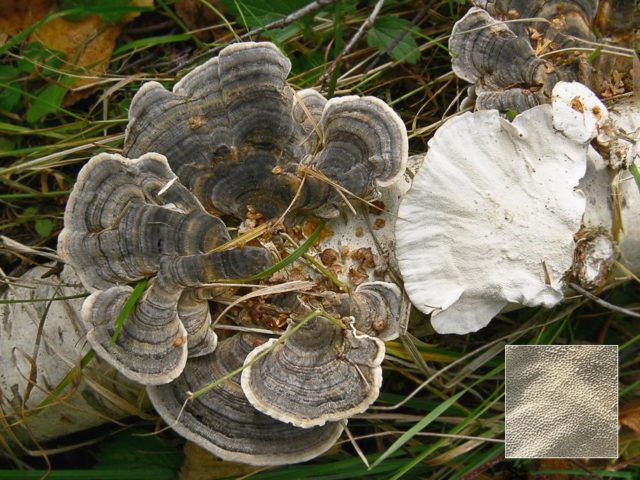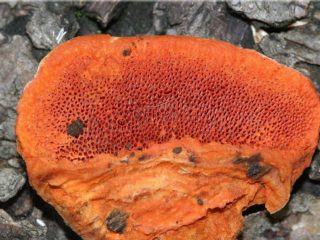Content
Trametes versicolor is a woody fruiting body from the large family Polyporaceae and the genus Trametes. Other names of the mushroom:
- Polypore polypore, azure;
- The tinder fungus is variegated or multi-colored;
- Coriolus multicolor;
- Turkey or peacock tail;
- Cuckoo's tail;
- Boletus is dark brown;
- Variegated mushroom;
- Misty mushroom or wungji;
- Kawaratake or mushroom growing near the river;
- Cellularia cyathiformis;
- Polyporus caesioglaucus;
- Polystictus neaniscus.

Trametes multi-colored, entwined with ivy
Description of multi-colored trametes
Trametes multicolored consists of a cap attached sideways to the substrate. The leg is absent even in its rudimentary form. The shape is fan-shaped, rounded-folded. Very rarely it can form a petal rosette. The surface of the cap is dry, varnish-shiny, pleasantly silky. Partially covered with fine velvety pile. The edge is pointed or rounded, usually white and cream. The radius of the cap can vary from 2.5 to 10 cm.
Multi-colored trametes in appearance resembles a fancifully decorated bird's tail or a photo of Jupiter cropped in half. Concentric semicircles of varying widths and the most amazing colors go from the place of growth to the edge. All the colors of the rainbow are far from the limit for this original. The most common shades are black and dark brown, red-ocher-yellow, and blue-green. May have a grey-silver, cream, lilac or azure color.
Heminophore tubular. In a young mushroom, the mouths are barely distinguishable, the surface is velvety, white-cream and yellowish. Then the pores expand, becoming noticeable, angular, of various shapes, and the color darkens to brown-ocher and reddish-brown.
The pulp is dense, rubbery, very thin. It does not break and is difficult to tear. On the crack there is a fresh yellowish-brown mushroom.The dried fruit body has a white-beige color. The aroma is barely perceptible mushroom, the taste is practically not felt.

The inner surface of the multi-colored tramethes is folded, the pores are almost invisible
Where and how does it grow
Trametes versicolor is widespread throughout the globe. But in Russia it is little known and practically not used. You can meet him all year round. Prefers deciduous, moist forests. Loves loose wood of poplar, willow, and aspen. It also feels great on birch, oak, and hornbeam trees. Occasionally found on coniferous trees. The rapid development of fruiting bodies occurs from mid-summer to late autumn.
Can settle on dead trees, dead wood, stumps, loves old clearings and fires. It grows on the damaged bark of living trees in large, rapidly growing groups, capturing new territories during the season. Often individual fruiting bodies form a single organism. The mycelium remains in one place for many years until the wood is completely destroyed.

The tree on which this handsome man settled dies very quickly
Is the mushroom edible or not?
Trametes versicolor belongs to the category of inedible mushrooms. Recent studies have discovered biologically active substances in its composition. These fruiting bodies do not contain toxic or poisonous compounds.

The hard, woody pulp makes trametes versicolor unsuitable for culinary use.
Doubles and their differences
Thanks to its unusual coloring, Trametes multicolored is easily distinguishable from similar fruiting bodies of the Tinder species.
Variegated scaly tinder fungus. Conditionally edible tree mushroom. Can be distinguished by pronounced scales on the outer surface of the cap and a more faded color.

The scaly polypore has a thick eccentric leg with which it is attached to the tree
Trametes coarse-haired. Inedible. It is distinguished by its gray color and hard fluff on the top of the cap.

The tubular spore-bearing layer is beige-brown, the spore mouths are uneven, angular
Trametes is fluffy. Inedible. It is an annual plant and can be distinguished by its pubescent cap and duller, gray-olive color.
Heminophore spongy, with clearly visible pores, gray-brown color
Medicinal properties of multi-colored tinder fungus
Despite the extremely cautious attitude of official pharmaceutical science, Trametes versicolor is widely used in traditional medicine of various peoples as a medicine. It found especially widespread use in the East: China, Japan. In Russia, the mushroom is almost unknown; only in some regions can you find references to its use as a healing infusion or ointment. It contains:
- Phenolic and flavonoid antioxidants that help strengthen the immune system, reduce inflammation and protect the body from premature aging.
- Polysaccharides that strengthen the immune system at the cellular level, helping to fight various diseases, including oncology, and reduce and eliminate inflammatory processes.
Prebiotics contained in the pulp of tramethes multicolored help normalize digestion, have a beneficial effect on the development of beneficial gastrointestinal microflora and suppress the growth of pathogenic bacteria.

The mushroom is not only beautiful, but also has a number of useful properties.
Use of variegated tinder fungus
Thanks to laboratory research in recent years, about 50 unique polysaccharides, including Coriolane, have been isolated from fruiting bodies and mycelium. It has a beneficial effect on cell immunity and helps the body fight repeated metastases after surgery.
Tramets versicolor products help reduce inflammation and fight a number of pathogenic bacteria and viruses. They allow you to increase efficiency and eliminate fatigue, and also have a beneficial effect on patients with diabetes.
Fruiting bodies can be harvested in August and September. Young, not overgrown mushrooms should be collected. Once cleared of forest debris, they can either be dried or used as a decoction.

Trametes versicolor is rightfully considered a unique medicine with a wide spectrum of action.
In traditional medicine
In China and Japan, fungotherapy is recognized as official medicine; the history of using mushroom pulp for therapy goes back more than 20 centuries. The medicinal properties of multi-colored tramethes are different, as are the methods of its preparation. Powders, ointments and tinctures are prescribed to patients for the following diseases:
- liver problems, including chronic hepatitis;
- decreased immunity;
- viral infections: herpes, lichen, influenza and cytomegalovirus;
- fungal infections - candidiasis, ringworm and others;
- prevention and treatment of cancer;
- rheumatism, diabetes mellitus, hypertension, wet cough;
- problems of the cardiovascular system;
- Trametes versicolor is prescribed for dermatomyositis, sclerosis, lupus;
- used in complex treatment of the gastrointestinal tract.
In folk medicine
Method for preparing an alcohol tincture from the multi-colored trametes mushroom:
- dried powder – 20 g;
- vodka 40% - 300 ml.
Infuse mushroom powder in alcohol for 14-30 days. Before taking, be sure to shake, pouring along with the sediment. Take 3 times a day 20-25 minutes before meals, 1 tsp. within 15 days.
Method for preparing a decoction of multi-colored tramethes:
- crushed fruit bodies - 4 tbsp. l.;
- water – 1 l.
Cover the mushrooms with water and cook over low heat for 1 hour. Strain through cheesecloth or a fine sieve and cool. Take 2 times a day, half an hour before meals, 1 glass.

The healing effects of folk recipes from multi-colored tramethes are very effective
For oncology
The healing practices of many nations recognize Trametes versicolor as a cure for various cancers. In Japan, infusions, ointments and decoctions are necessarily prescribed along with radiation, before and after procedures. People taking 1-4 g of powder along with traditional treatment showed better dynamics.
For cancer ulcers, an ointment made from animal fat and dried crushed mushroom is good.
Trametes versicolor powder is indicated for breast cancer.
Decoctions and infusions of the fruit body help prevent cancer of the internal organs of the gastrointestinal tract.

Infusions and decoctions of Trametes versicolor can also be taken for benign formations: adenomas, papillomas, polyps
Conclusion
Trametes versicolor is a unique medicinal mushroom. Grows on old stumps, rotting wood and damaged or dying trees. Loves damp places and deciduous wood. Inedible due to its hard pulp, but does not contain toxic substances. No toxic doubles were found in him either. Used in folk and official medicine in different countries. In Russia it is not recognized as a medicinal product.









